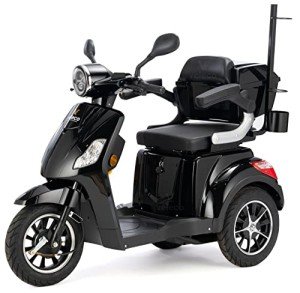A Comprehensive Guide to Buying a Mobility Scooter
Mobility scooters have become an essential tool for lots of individuals seeking to enhance their self-reliance and mobility. With a large array of designs and features readily available, choosing the best mobility scooter can be daunting. This article provides a helpful guide to assist consumers navigate their choices, assess their needs, and make a notified purchase.
Understanding Mobility Scooters
Mobility scooters are electric vehicles designed for individuals who experience mobility difficulties. They are especially helpful for senior citizens, those with disabilities, or people recuperating from injuries. Mobility scooters can vary widely in terms of style, features, and prices.
Types of Mobility Scooters
Before starting a purchase, it's important to comprehend the different types of mobility scooters readily available:
Three-Wheel Scooters:
- Generally more maneuverable in tight areas
- Lightweight and portable
- Suitable for indoor use
Four-Wheel Scooters:
- Offer higher stability and balance
- Appropriate for outside usage over various terrains
- Usually have a longer battery life
Foldable/Portable Scooters:
- Designed to be quickly transported and stored
- Can typically suit the trunk of an automobile
- Suitable for those who travel frequently
Sturdy Scooters:
- Built to accommodate bigger individuals
- Frequently featured more robust features for outside usage
- Usually geared up with bigger batteries for extended variety
Factors to Consider When Buying a Mobility Scooter
1. Weight Capacity
Choose a mobility scooter that can support the user's weight. Most scooters have a weight limitation varying from 250 to 500 pounds. It is crucial to guarantee that the scooter can accommodate the user easily.
2. Variety and Battery Life
The range is how far the mobility scooter can travel on a single charge. Normal varieties differ between 10 to 30 miles. Consider the user's day-to-day activities and choose a scooter with an ideal variety.
3. Scooter Dimensions
Consider the size of the scooter, including its weight and measurements. A more compact scooter might be perfect for narrow corridors and tight spaces, while larger designs offer extra stability and comfort.
4. Terrain Capability
Assess where the scooter will mostly be used. If the user prepares to travel mainly on pavement, a lightweight model may be sufficient. However, if the user requires to traverse gravel or unequal surface areas, consider a four-wheel scooter constructed for off-road usage.
Leading Features to Look For
Comfort
- Adjustable Seats: Look for scooters with cushioned and height-adjustable seats to ensure convenience during travel.
- Armrests: These enhance security and assistance while navigating.
Safety and Visibility
- Headlights and Taillights: Essential for nighttime use.
- Turn Signals and Reflectors: Improve visibility and security while on the roadway.
User-Friendly Controls
- Joystick or Drive Controls: These should be instinctive and simple to control.
- Easy-to-Read Displays: A control board that reveals battery life, speed, and range can boost the user experience.
Additional Features
- Storage Compartments: These provide added benefit for carrying personal products while on the go.
- Weather Protection: Consider models with rain covers or windscreens if utilized in variable weather.
Cost Considerations
When budgeting for a mobility scooter, rates can range anywhere from ₤ 500 to over ₤ 5,000 depending on the model, features, and brand. Extra costs might consist of:
- Extended Warranty: Protects against flaws and can conserve money in the long run.
- Accessories: Optional features, such as upgraded seats, lights, or storage services.
| Feature | Cost Range |
|---|---|
| Standard Models | ₤ 500 - ₤ 1,500 |
| Mid-Range Models | ₤ 1,500 - ₤ 3,000 |
| High-End Models | ₤ 3,000 - ₤ 5,000 |
Funding Options
Lots of sellers offer funding strategies, and some city government efforts may offer grants or help for those in need. Investigate prospective monetary assistance with community resources or mobility service organizations.
Frequently asked questions about Buying a Mobility Scooter
What is the difference between a mobility scooter and a wheelchair?
Mobility scooters are motorized and permit users to navigate individually, while wheelchairs might require physical assistance or manual operation.
How do I maintain a mobility scooter?
Routine maintenance includes examining battery life, cleaning up the scooter, and inspecting tires and brakes. Constantly describe the user manual for specific standards.
Can mobility scooters be utilized inside?
Yes, numerous designs are designed for both indoor and outdoor usage. However, three-wheel scooters tend to be better fit for indoor navigation due to their tighter turning radius.
Are mobility scooters covered by insurance coverage?
Some insurance coverage prepares cover a portion of the expenses for mobility scooters if they are deemed medically needed. Contact your supplier for specific information.
How quickly can a mobility scooter go?
A lot of mobility scooters have an optimal speed varying from 4 to 8 miles per hour. Nevertheless, mymobilityscooters might vary depending on regional guidelines.
Getting a mobility scooter can significantly boost one's independence and lifestyle. By understanding the types, features, and costs associated with mobility scooters, potential purchasers can make well-informed choices that fit their requirements and choices. Customization and thorough research are essential to ensuring satisfaction with this essential investment.

